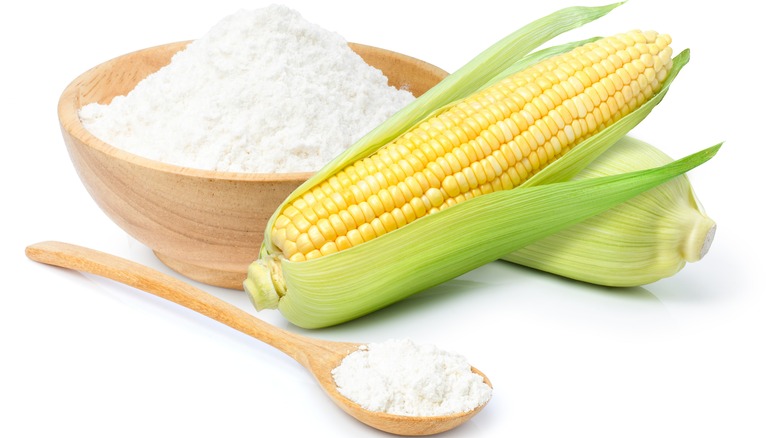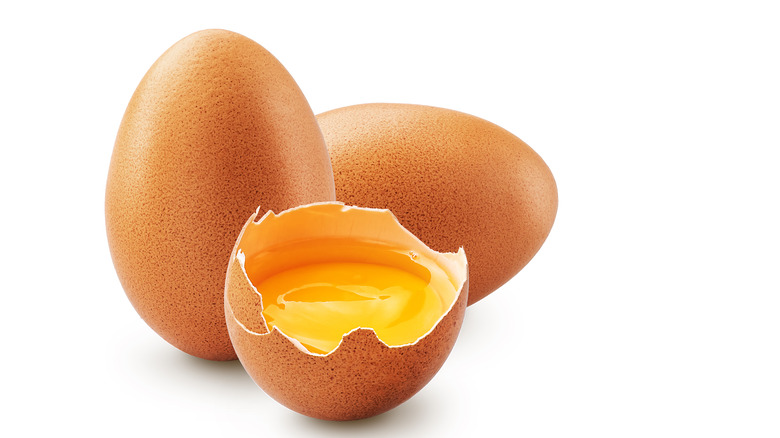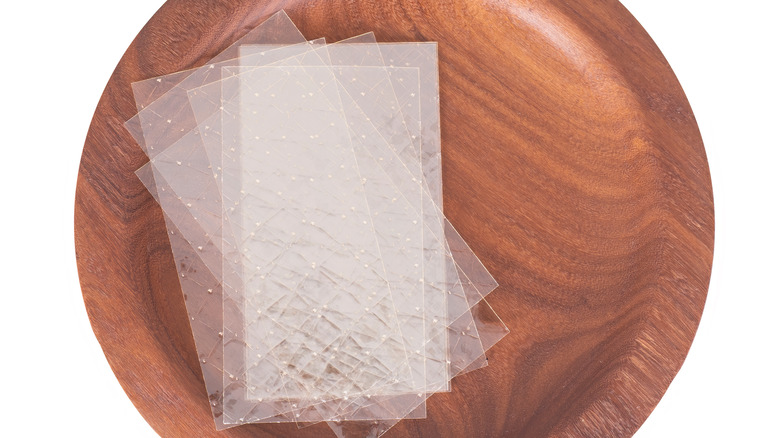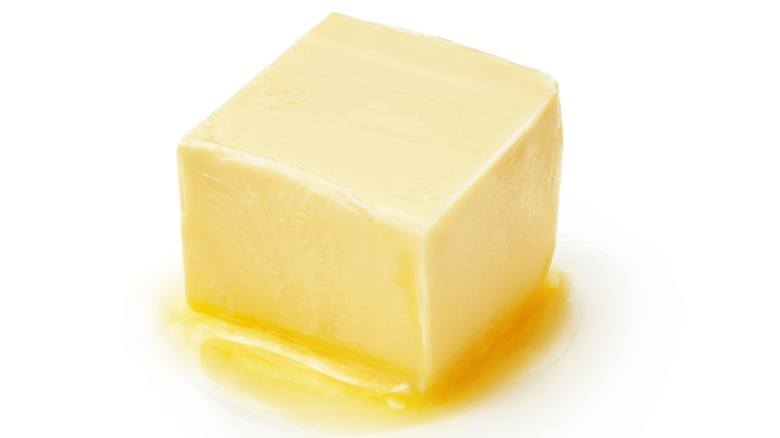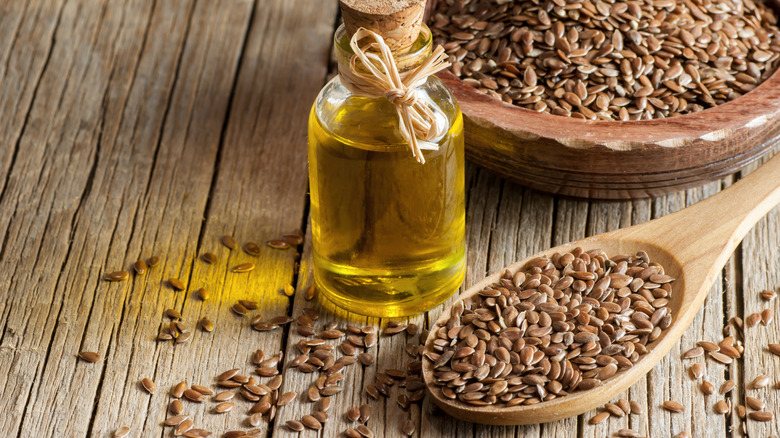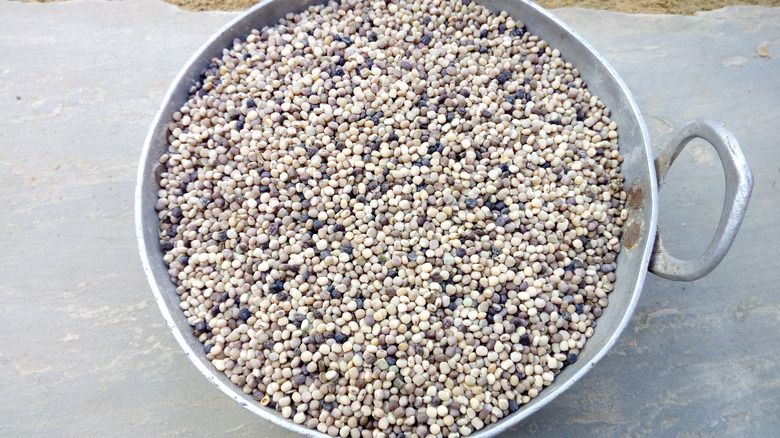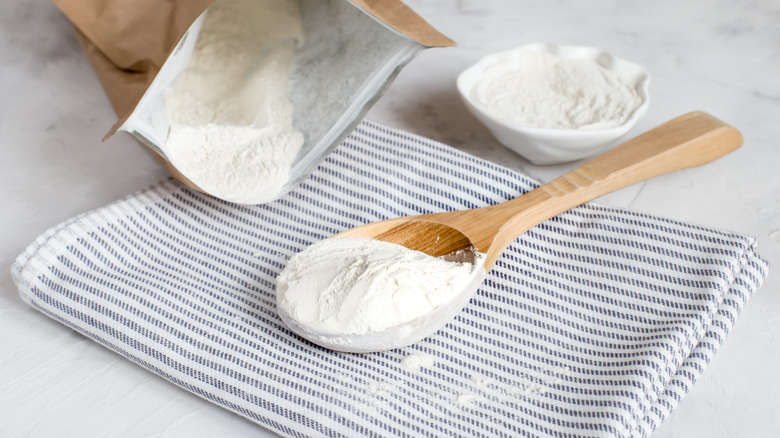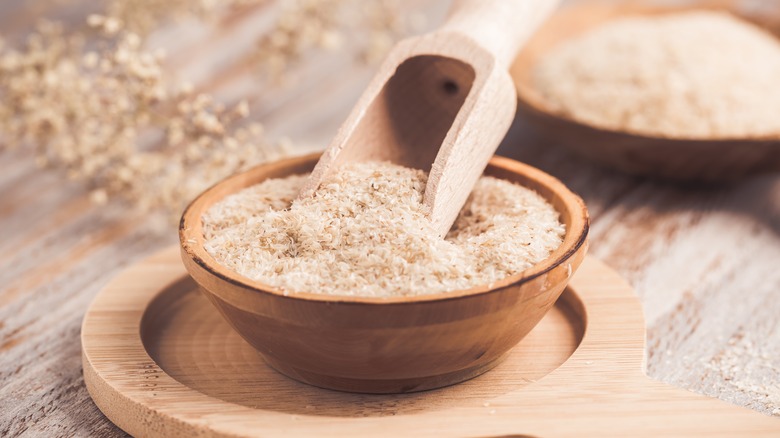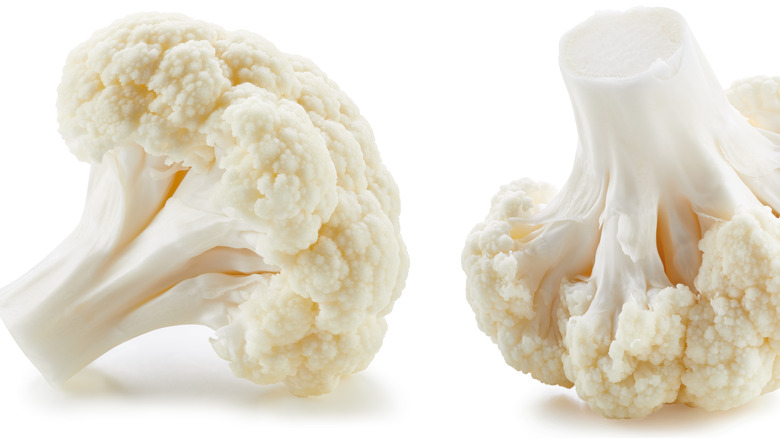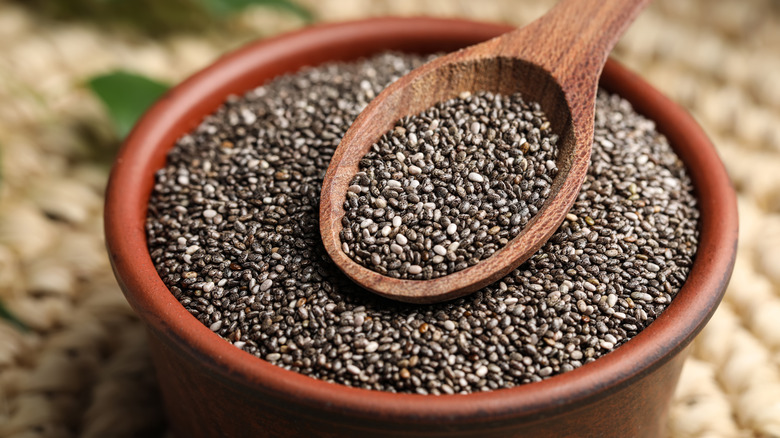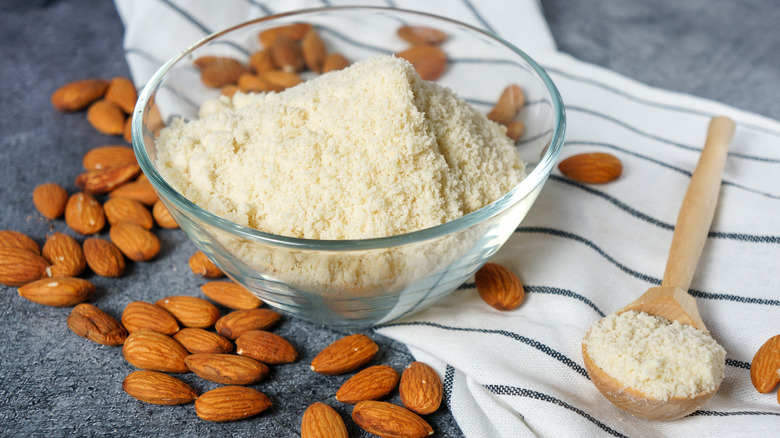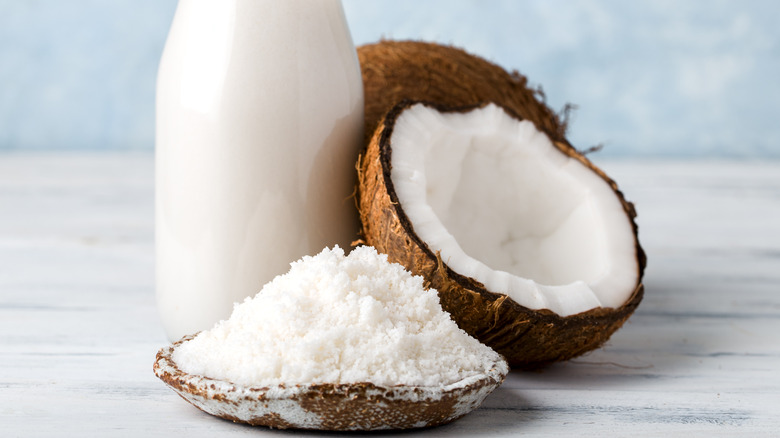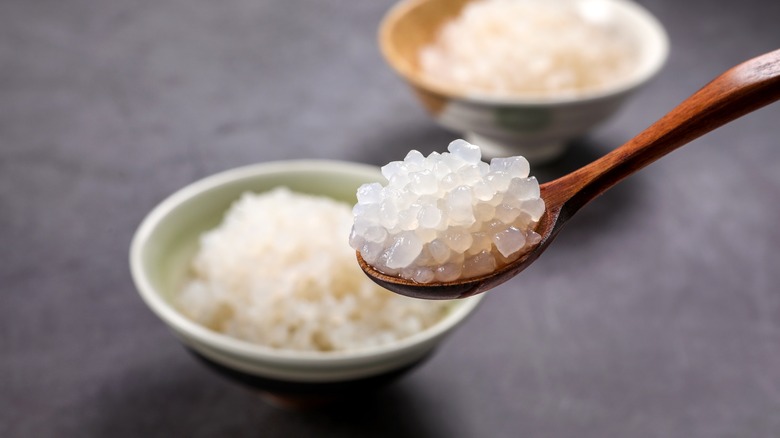The Best Keto Alternatives For Corn Starch
A keto, or ketogenic, diet is a low-carb, high-fat diet intended to put your body in the fat-burning metabolic state of ketosis (via Healthline). This way of eating has been shown to have a link with reducing insulin levels and blood sugar in the body. And though there are many forms of ketogenic diets, scientific studies indicate that high protein versions of keto may be the most nutritious form of the diet, even though they may take the longest to reach ketosis (via Insider). As with any diet, you should consult with your doctor to determine if this is the right way of eating for you. If you've already done so, chances are you are on the hunt for keto-friendly alternatives to common ingredients like cornstarch.
No matter how you eat, you want to make sure your food is tasty, and texture plays a big role in how we feel about our food. Many items are used to have an effect on food texture, and cornstarch is one such ingredient. But, what is cornstarch, and how do you use it? Well, it's an ingredient that pops up in many recipes as an amazing thickener, tenderizer, and crisper. Most of us probably don't even think of its nutritional implications. The fact is, cornstarch has 7 grams of net carbs and 0 grams of fat per tablespoon — not ideal for a keto diet. If you are eating this sort of lifestyle, chances are you are in need of some substitutes. Fortunately, the best keto alternatives for cornstarch have many valuable uses beyond making your food taste or feel better.
Thicken sauces with egg yolks
Eggs are a staple food in many keto diets, and they might be the most keto-friendly alternative for cornstarch. Not only are they incredibly low in net carbs, but they're high in fat and protein (via USDA). Be careful when it comes to eggs as a keto alternative to cornstarch. When thickening, you don't want to toss your egg yolks right into a hot sauce, unless you'd like to end up with scrambled eggs. To use egg yolks as a thickener, you'll need to temper them first.
To do that, whisk your egg yolks in a bowl separate from your hot liquid. Next, gradually add part of your hot liquid to the yolks, whisking as you go. This will warm up the mixture, ensuring your eggs don't curdle. After that's well incorporated, add your tempered eggs to your main sauce/soup pot, slowly mixing as you do. Make sure not to boil your liquid, or your hard work will be for naught, and you'll still end up with scrambled eggs.
You can also use egg yolks in any sauce that calls for a roux — just skip the flour. One of our favorite ways to substitute eggs in place of cornstarch? Using them to thicken tomato sauce.
Make pudding with gelatin
The thing about many superb keto-friendly alternatives to cornstarch is they require a little fine-tuning and finesse, so don't despair if your recipe isn't perfect from the word go. At 0 net carbs, gelatin is one such alternative — a little goes a long way. Though you won't be eating a lot of gelatin when you add it to your dishes, you will still be reaping its nutritional benefits. Gelatin is rich in amino acids that have been shown to improve joint and bone health, as well as the appearance of skin and hair (per Healthline).
Believe it or not, you can still eat pudding on a keto diet. Here, use gelatin to replace cornstarch, and an alternative sweetener such as erythritol, stevia, or monk fruit, instead of sugar. Using gelatin, like in our mango pudding recipe, isn't very different from using cornstarch; they're both activated by heat and set after cooling.
But pudding isn't the only place where you can use gelatin to replace cornstarch. It works well in sauces such as Mashed's KFC mashed potatoes and gravy copycat recipe. Just be careful you don't add it too quickly, or you might add too much and end up with a gelatin salad reminiscent of the 1960s. (Unless, of course, that's your goal.)
Add a pat of butter
Yes, we hear you. Butter as a thickener? Absolutely. If you don't need your sauce or soup to be too thick, finishing it off with a pat of butter is a great way to add some creamy texture. That's because butter has a high-fat content and all sorts of natural emulsifiers, which help to bind and stabilize when cooking. So, when it comes together with the liquids already in your sauce, they get thicker.
At the end of the day, sometimes you don't want your food to get too thick. Cornstarch can get clumpy or make your food gel-like. Butter is a thickener you can control more easily — and as we all know, it adds that unbeatable lip-smacking "oomph" with which cornstarch just can't compete. Plus, butter is a great food for keto, as it's super high in fat but has no net carbs (via USDA). Keto-followers love butter so much that some even add it to their morning java for a drink called bulletproof coffee.
Bake with flax meal
Many people use cornstarch as a simple plant-based egg replacer in their baking. Unfortunately, while beneficial for vegans, it's not very keto-friendly. Luckily, flax meal is also an excellent ingredient substitute every vegan should know about, with the added benefit of being high in protein, with less than 1 net carb per teaspoon (via USDA).
There are a couple of ways to make a flax egg; for both, you'll need 3 tablespoons of water for every tablespoon of flax meal. In the first method, you can simmer your ingredients together — this will create an especially gelatinous egg. If you don't want to deal with the extra clean-up, you can whisk together the flax meal and water in a small bowl and let the mixture sit for ten minutes. This method will result in less of a tight glue but still works well to bind in the ways that cornstarch does. You can also use flax in place of cornstarch or flour in a roux (but know that your dish will take on a browner color with flecks of the flax).
Go with guar gum
While it might sound like a space-age ingredient, the truth is that guar gum is one of the absolute best substitutes for cornstarch and is totally natural and keto-friendly. Guar gum is made from the guar bean and sold in powdered form with 0 net carbs. Better yet, it can replace cornstarch in practically any application. But be careful; when using guar gum, you'll only need ⅛ of the amount of cornstarch the recipe calls for. Overdo it, and you'll end up with a dish that is, you guessed it, gummy.
While going overboard on the guar gum might be a risk, it's still an easy ingredient since it works with cold or hot liquids. You read that right! Guar gum functions by expanding in your liquid, and research has shown that it's not temperature-dependent in terms of viscosity. It can, however, clump up if you don't mix it well enough. So, sifting and whisking it into your liquid is a good way to go.
Why not try guar gum in place of cornstarch in our classic cheese fondue recipe? (Bonus tip: try roasting cauliflower or radish as keto-friendly dippers.) Or, if you're looking for something a little meatier, try using some guar gum in our Vietnamese shaking beef recipe.
Substitute with xanthan gum
Xanthan gum can be important to keto diets, and for all that it is made from fermented sugar, it actually has no net carbs. It is a very common replacement for corn starch as it is an excellent thickener. In fact, you've probably seen it in the ingredient list for many gluten-free foods, salad dressings, and ice creams.
So why should you start keeping xanthan gum in your pantry? If you're on a keto diet, you'll appreciate that xanthan gum is a good way to keep sauces and soups thick without adding carbs into the mix. Also, for any vegan keto-followers out there, xanthan gum is an excellent egg replacer.
We do have a few caveats. Consuming large amounts of xanthan gum may give you a stomach ache. And, getting your proportions right in cooking with xanthan gum can be a little tricky. It's harder to control than some other of these alternatives. If you use too much, your dish can become slimy — which we can all agree is not very appetizing. But, if you're willing to take the time to experiment, it is a worthy keto-friendly alternative to cornstarch.
Throw in some psyllium husk
Yes, many dietary fiber supplements (read: laxatives) are made from psyllium husk, but we assure you that it is one of the best keto alternatives for cornstarch. Its high dietary fiber content amounts to a net carb count of 0 grams. Perhaps the biggest downside, however, is that psyllium husk is also devoid of fats and proteins.
What exactly is psyllium husk? According to Healthline, it's the husk, or outer layer, of the seed of a plant called Plantago ovata. So how does this husk work as a keto replacement for cornstarch? As a soluble fiber, psyllium husk thickens by taking moisture from the environment around it. In your food, that acts as a great binding agent.
That means you can use psyllium husk to replace cornstarch in places where a non-keto diet might call for its use as a thickener or binding agent in baking and sauces. Just be careful not to eat too much of this husk; you'll end up with bloating and a tummy ache.
Puree some veggies
Many people don't think of vegetables when they think of keto diets, but that's simply not the case; there are so many low-carb veggies out there. Everyone needs to eat veggies. Not only do vegetables add much-needed nutrients to any diet, but they can also serve as an alternative to cornstarch, partially due to the pectin found within the cell walls of many of these foods (via the Food and Agricultural Organization of the United Nations). Moreover, veggies are much easier to access than other items on this list.
The best application for veggie puree as a cornstarch alternative would be in soups, though they could work in sauces and baking, depending on your flavor profile. According to the folks over on the subreddit ketorecipes, cauliflower, in particular, is a great vegetable with which to work. Other keto-friendly vegetables that puree well include broccoli, eggplant, and zucchini — all of which are relatively low carb when it comes to plant-based produce (as opposed to beans, peas, legumes, and tubers). If you've got a few extra carbs to spare, you could even try carrots or winter squash.
Chia seeds make it easy as pie
Another place that you'll find cornstarch hiding in plain sight is pies. So what's a keto-follower to do? Well, chia seeds are no longer just "hippie chow." They have been in pudding and jam for a while now, and you should've started adding chia seeds to your overnight oats yesterday. So, it's only fitting they'd find their way into pies. Just as cornstarch does, the chia seeds in pie filling keep it from becoming too runny. Making a chia-seed pie filling is very similar to making a chia-seed jam recipe. The key difference is you'll need to use an artificial sweetener that is keto-approved.
Chia seeds are a great keto alternative to cornstarch since they are low-carb and high in fat and protein (via USDA). And, pie isn't the only place you can use them as a replacement. Like flax, you can use ground or whole chia seeds as an egg replacement. Again, use 3 tablespoons of chia seeds for each tablespoon of seeds. Unlike flax, chia seeds work better if you let them sit in the fridge overnight rather than heating them.
Add almond flour
Cornstarch isn't just a thickener, though. It can be used as a breading on meats, tofu, and vegetables to create a crispy crunch. How can you achieve that in a way that fits your keto needs? Almond flour can help you out. With a robust nutrition profile, almond flour only has about 4 net carbs, 15 grams of fat, and 6 grams of protein.
Now, almond flour works best in places where you'd normally use a thin coating of cornstarch — like fish or tofu — rather than thick batters like fried chicken (via Reddit/ketorecipes). Known as a keto alternative for wheat flour, it is also possible to use almond flour in place of flour or cornstarch in a roux, but it won't create quite as thick a base for your sauces. Another important note to remember is that almond flour and almond meal aren't the same things; Almond meal is ground more coarsely and doesn't mimic cornstarch the same way that finer textured almond flour does.
Almond flour is a good option to consider if you want to add some nutrients to your meal. According to Healthline, among many of its cooking benefits, almond flour is also packed with vitamin E and magnesium. Vitamin E helps fight cancer-causing free radicals in your body. Meanwhile, magnesium works hand in hand with almonds' low glycemic index to help manage blood sugar levels. That makes almonds a good choice for people with type 2 diabetes.
Replace with coconut flour
Like almond flour, coconut flour works well as a breading and can be used to make a roux. Yet, at 4 net carbohydrates per serving, it too is higher in net carbs than many of the other keto alternatives to cornstarch that you can find on this list. But, bear in mind that you won't be consuming much of the flour, and fortunately, coconut flour is high in fiber and protein, making it a workable option on a keto diet. As a bonus, coconut flour is high in potassium and iron. Per Healthline, many people nowadays don't consume enough fiber or potassium, so swapping out coconut flour for cornstarch serves as an extra perk in this sense as well.
To use coconut flour as a thickener to a sauce, sprinkle it on top of your liquid. Or, to make a roux, mix it with your fat in place of flour. Do remember that, unlike cornstarch, coconut and almond flour might alter the taste of your recipe. In situations where a tropical tilt is needed, coconut flour not only adds the cornstarch-free texture you need but also an equatorial flavor.
Sub in glucomannan powder
Glucomannan powder might sound like a superhero's secret weapon, but it's made from konjac root. You may recognize konjac since it's the base ingredient for shirataki noodles, a low-carb alternative to pasta. Gluocamman, especially in the form of shirataki noodles, is practically carb and calorie-free, according to the USDA. But, due to its very high water-absorption ability, it keeps people full, which makes it popular among folks trying to lose weight. For this reason, it's often sold in capsules as a powdered weight-loss supplement.
How do you use it as an alternative to cornstarch? According to Konjac Foods, you can use glucomannan as a swap for cornstarch in virtually any thickening application. Like, cornstarch, you'll want first to create a slurry. You should make your glucomannan slurry in cold water and let it absorb the water before adding it to any hot liquid. That's because glucomannan is powerful, and it activates with heat. By dissolving it in cold liquid first, you can avoid clumps. Speaking of strength, when you cook with glucomannan, only use ⅒ the amount of cornstarch your recipe suggests.
Try a little heat and time
Of course, if none of these options are available to you, you don't want to risk changing your dish's flavor, or you can't afford to add any carbs to your food — you can always let science do its thing. With enough time and temperature, you'll have one of the best substitutes for cornstarch. That's because most liquids tend to thicken and reduce, so you won't need carb-heavy cornstarch, to begin with.
This is an especially great option for gravies or tomato-based sauces. The best part about a sauce reduction is that it concentrates the flavor, making your dish extra tasty. This process works because the water evaporates, leaving you with a thicker sauce, whereas cornstarch absorbs the water and then expands. Besides looking at this through the lens of carbohydrates, a reduction is a better choice than cornstarch in many situations, such as when making a tomato-based sauce. In this circumstance, the starch and acid in tomatoes don't play together all that well. Plus, cornstarch doesn't like to be reheated, and we all know that tomato sauce is one of the best-tasting leftovers out there.
